Starting hands range
When you play poker, you should be relative consistent regarding which starting hands you play in different situations. Instead of making up your mind from time to time, you should have a constant plan. For your help to visualize all possible starting hands, these ranges can be very helpful.
Hand range charts
The charts are categorized by the percentage of hands. Notice that a 10% range, for example, isn't the same as 10% of the the hands displayed in the charts – there are more combinations of some hands (see Number of combinations for different hand categories), therefore, the marked hands versus unmarked in the chart doesn't coincide with the percent numbers.
The narrower the range of the opponent, the higher the risk for strong hands. The term ”density” is used for this. A small range has high ”density” for hands such as AQ and AK.
10% range - extremely tight
This chart displays a 10% range in pre-flop:
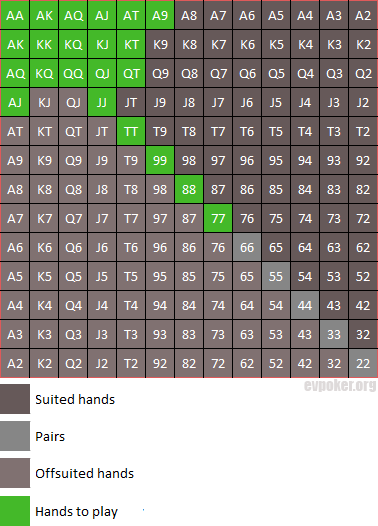
Hand range: 77+, A9s+, KTs+, QTs+, AJo+, KQo
This hand range is extremely tight. It isn't generally recommended to play as few hands, but can be a good way to start in poker if you're a beginner (only playing strong hands makes the decisions easier). It could also be the range from UTG (under the gun, the position that is first to act in a hand).
The advantage with only playing the best starting hands is that you avoid many hard decisions with marginal hands. On the negative side is the need for patience and fewer possibilities to take advantage of weaker players.
15% range - very tight
This chart displays a 15% range in pre-flop:
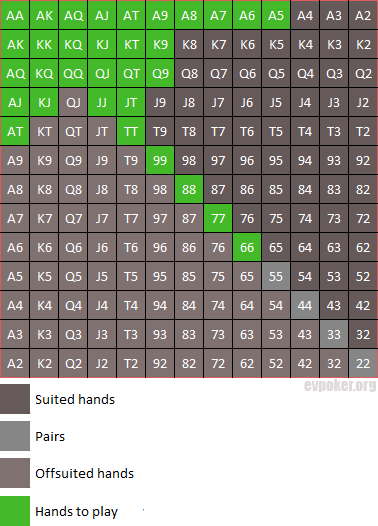
Hand range: 66+, A5s+, K9s+, Q9s+, JTs, ATo+, KJo+
This hand range is very tight. It is recommended to play more hands in general, but in early to middle positions could this range be well suited. Hands like 6-6, A5s and A-To are, however, not recommended to play in first position.
This hand selection could also be used in a more general approach on long-handed tables with 8-10 players where it is extra important to be tight pre-flop.
20% range, version 1 - tight with speculative hands
This chart displays a 20% range in pre-flop:
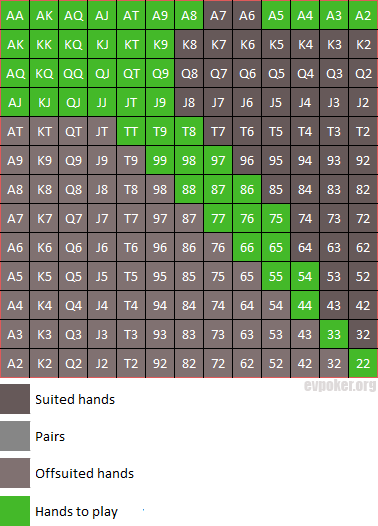
Hand range: 22+, A2s+ (A7, A6), K9s+, Q9s+, J9s+, T8s+, 97s+, 86s+, 75s+, 65, 54, AJo+, KJo+, QJo
This hand range is tight, but on the same time include many speculative hands. It can be suited to use in middle positions and especially on long-handed table. The reason for not include A7s-A6s despite A5s-A2s are included is because low aces have better chances to construct straights. Middle ranges aces are also marginal hands that are hard to play and often lose much money to better aces.
It may seem strange to not include a hand as AT and on the same time play 7-5s and 5-4s.
This range may perform best on 8-10 seat tables, in which A-T will often be dominated by better aces. Speculative hands such as 7-5s, on the other hand, will often get enough pot odds in family pots and have potentials to beat many strong hands.
20% range, version 2 - tight with early knockout hands
This chart displays a 20% range in pre-flop:
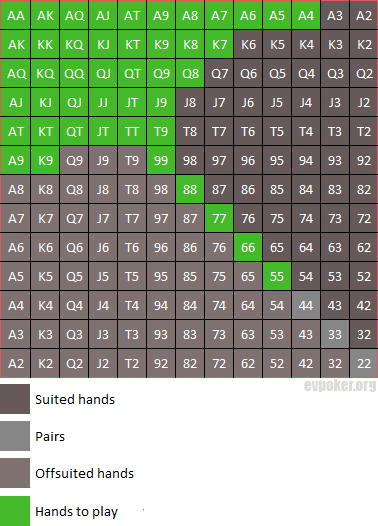
Hand range: 55+, A4s+, K7s+, Q8s+, J9s, T9s, A9o+, K9o+, QTo+, JTo
Compared to the 20% range version 1, this hand selection is more focused on hands that win pots directly on the flop, but don't include as many speculative hands; neither low pocket pairs, which can be considered speculative as well since they often must hit a set to win the pot. This range is suitable for tight-aggressive players and in middle positions on max-6 tables.
25% range - balanced
This chart displays a 25% range in pre-flop:
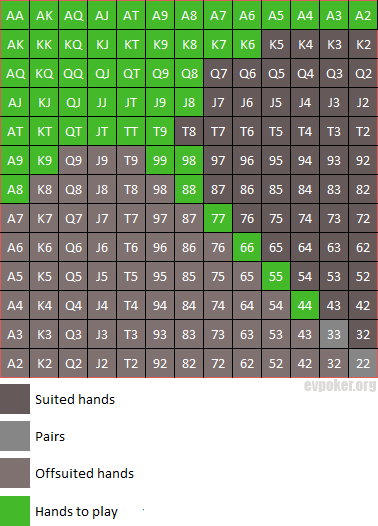
Hand range: 44+, A2s+, K6s+, Q8s+, J8s+, T9s, 98, A8o+, K9o+, QTo+, JTo
This chart includes hands that generally should be included in your hand selection. In early positions, though, you should definitely consider excluding the less strong hands and in late positions add more hands.
If you want to elaborate further with pre-flop hand ranges, here's a great tool.
Related articles:
